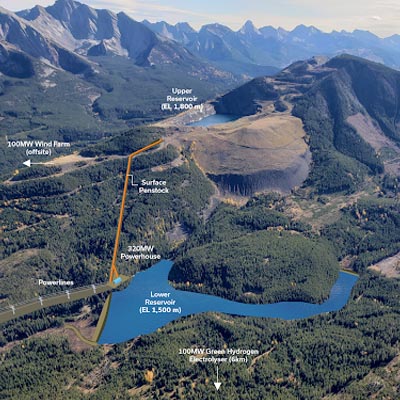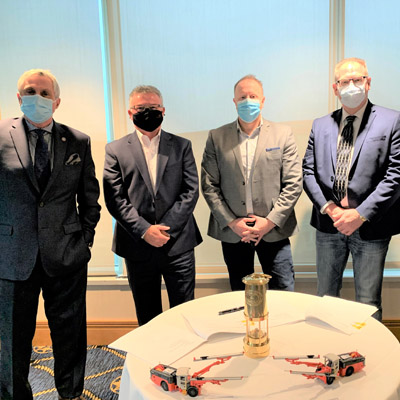The Kimberley connection
Connecting the miners of Fort McMurray to the heart of the Rockies
Kimberley, B.C., in the heart of the Rocky and Purcell mountains, is a place where comfort and adventure unite. The city of 6,000 people is home to first-class recreational opportunities like hiking, biking, skiing, snowboarding and golfing. Most importantly, it is safe, affordable and a great place for families to raise their children. These characteristics are what the City of Kimberley is trying to promote to the many miners who commute to or work in Fort McMurray, Alberta.
In comparison, the Muncipality of Wood Buffalo, which includes Fort McMurray, paints a much different picture. According to Kevin Wilson, economic development officer for the City of Kimberley, Wood Buffalo has more than 25,000 people living in work camps. That's over and above the 75,000 people living in an urban development area built for 40,000 people.
Wilson and Al Mulholland, the CAO for the City of Kimberley, recently travelled to Fort McMurray for the purpose of promoting the East Kootenay city as a potential home for the miners and workers of the oilsands.
"Visually, everything is under construction in Fort McMurray," said Wilson. "The one main road that runs through town is Highway 63, which runs from Edmonton to just north of Fort McMurray. They have five or six stop lights that go through town on this main artery, and when you're trying to move 75,000 people from residential areas to north of town and into the city, the congestion is very noticeable."
Fort McMurray is an urban development area within Wood Buffalo, but the municipality doesn't control the land within its region. The regional municipality includes the land on which oilsands leases are found, so a lot of it is subject to provincial approval. Wilson said just the time frames to get approval to build have created a huge backlog. So basically, the city cannot grow as quickly as its population is growing or as the demand for workers and miners is growing.
Mutual benefits
The mutual benefits for miners living in Kimberley and working in Fort McMurray are great. According to Wilson, Kimberley has excess capacity. It has the infrastructure and residential accommodation for a population much larger than it has currently.
"At the same time, we have a population of experienced, educated folks who are familiar with mine working conditions, procedures, protocols, technologies and those sorts of things," said Wilson. "From the Kimberley perspective, we could benefit from a larger local population in terms of local people buying local goods and services, supporting local businesses, supporting the local tax base and contributing to the vibrancy of the area."
Kimberley was built on mining. From 1917 to 2001, it was the home of the historic Sullivan Mine, one of the largest lead and zinc mines in the world. Many of the miners who lost their jobs when the mine closed now commute to mines across Canada. They go away to work and can feel relaxed and confident that their families are living in a safe and vibrant community back home in Kimberley. The affordability of the small city could also be a huge incentive for workers in Fort McMurray.
"We have a comparably low cost of living in Kimberley," Wilson said. "An average single-family dwelling is $255,000. In Fort McMurray it is $715,000. That's just because of the supply and demand. They have a limited supply of housing and an enormous demand for places to live."
Wilson goes on to say that if somebody who's making $150,000 a year working in the oilsands is paying $10,000 a year to fly back and forth, but is saving $500,000 on a home, it could make sense for that individual. On top of that, Wilson said, the worker's family is living in a place that is much more comfortable and has access to more recreational opportunities.
Miners usually work shifts that are two weeks on, two weeks off or some variation of this. Wilson said that for the most part people in Fort McMurray are commuting daily to work sites. That means there is a population living in the camps of upwards of 25,000 people who don't have accommodations in the area.
"When we were toured around Fort McMurray, the fact is it is not the seething cesspool of boomtown angst that the news projects it," said Wilson. "People are happy and there are nice places to live. They've just constructed a really beautiful multi-purpose recreational complex which has an arena, a library and those sorts of things. But they themselves admit they don't have the building capacity. That's still two, three to 10 years away. At the same time, they are projecting their population is going to double in the next 10 years. So the population of Fort McMurray is going to go from 75,000 to 150,000 people."
A lot of what's driving this is the construction of large mining operations and the ongoing operations of these facilities, as well as all of the related economic development when you have that kind of population growth.
Wilson said the people of Fort McMurray are crying out for more retail and service amenities. With an airport so close to the city, Kimberley could be a solution.
Access to Kimberley
The Canadian Rockies International Airport located just north of Cranbrook, B.C., is about 20 kilometres from Kimberley. Located conveniently out the town's back door, the airport provides a gateway to those who wish to live in Kimberley and work elsewhere.
Integra Air offers direct flights from Cranbrook to Edmonton and is hoping to establish direct flights to Fort McMurray in the near future. Dave McFarland, the airline's vice-president, said it is critical to provide miners and workers with a short and easy commute, since they are making the trip every few weeks.
"It becomes, I’m sure, quite onerous and tiresome after a while," said McFarland, who also made the trip to Fort McMurray with the Kimberley staff. "A number of people I’ve spoken with are spending upwards of a day travelling each way, going back and forth to and from work. So they are wasting that much of their time off just travelling."
The idea behind Integra Air's proposed service, and even now with company charters available, is that Fort McMurray's workers can reduce the time and hassle required in getting to and from work, McFarland said. Miners will be able to get to work quickly and be relaxed once they get there.
"The opportunity is there," said Wilson. "With the flights from Integra Air, you can easily come down to the East Kootenay for a week or two at a time, especially with all the opportunities for recreational property. There are lots of people trying to get a slice of the oilsands, but I think this is a good one for us."




